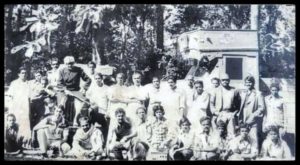By: Rusiraj Pattanayak
Kaptipada Estate in the district of Mayurbhanj was a separate Estate till its merger with Mayurbhanj in1890. From 1890, Kaptipada was continuing as a Sarbarakar under the rulers of Mayurbhanj.
The ancient history of Kaptipada Estate is wraped in obscurity. It is believed that during the reign of the Gajapati ruler Kapileswar Dev about the middle of 15th century A.D., the Naga chief Phanimukta founded this State. From the ruler Phanimukta to Sarat Chandra Jaya Bhujanga, the history of Kaptipada is uncertain. It is also believed that Sarat Chandra Jaya Bhujanga, the son of Niladwaja Kumar Parikshita Bhujanga founded the village Kaptipada on the bank of Sone river, where he built a fort. The 28th king of this Estate was Nrusimha Chandra Mandhata.

Chandra Sekhar Mandhata & Rama Chandra Mandhata were two sons of Nrusimha Chandra Mandhata who latter came to power respectively. During the reign of Abhinava Bhujanga Pitambara Mandhata, the son of Rama Chandra Mandhata, there was a Paika Rebellion against the royal family. After a severe fight between the army of Kaptipada & the rebels, the rebels occupied the fort of Kaptipada. Maharaja SriRam Chandra BhanjaDeo was named after the installed Goddess Kapotamundi. During the reign of Sarat Chandra Jaya Bhujanga, the headquarters of the Estate of Kaptipada was shifted from Kainsarigarh to Kaptipada on Sravana Purnima .
After Sarat Chandra Jaya Bhujanga, 27 kings ruled over the territory of Pitambara Mandhata, his Rani Subhadra Devi & his son Birabara Mandhata took shelter inside the temples of Virata Pata till the rebellion was suppressed. It is said that, during this period of rebellion, a barber lady led the army of Kaptipada against the rebels and defeated them.
Abhinava Bhujanga Pitambara Mandhata was succeeded by his son Parikhita Bhujanga Birabara Mandhata.
In the 37th Anka year of the Gajapati king Rama Chandra Deva III, Parikhita Bhujanga Birabara Mandhata issued a grant in favour of his junior Pradhan. After a short rule he turned mad. His queen Sita Devi managed the administration on behalf of the minor son Divyasimha Mandhata. There was a second Rebellion during her reign and Rani Sita Devi herself led the troops of Kaptipada with great courage. The battle took place near the tank of Suneikund between the rebels and Sita Devi’s army. After a crushing defeat, the rebels were retreated.

Again another rebellion broke out during the reign of Jaya Bhujanga Divyasimha Mandhata in 1880 & the fort of Kaptipada was burnt to ashes. Divyasimha Mandhata fled away from the burning fort with his family, but he succeeded in suppressing the rebellion after which he reconstructed the fort. Divyasimha Mandhata was a simple & honest ruler. During his reign he faced difficulties in realizing land revenue from his people.
During that time, the State of Mayurbhanj was under the administration of the Court of Wards owing to minority of SriRamaChandra BhanjaDeo. At that time, P. Wylly was appointed as the Working Manager of Mayurbhanj. SriRamaChandra BhanjaDeo took interest in the affairs of Kaptipada and wrote a letter to P.Wylly, requesting him to undertake the land settlement of Kaptipada. After receiving the letter from SriRamaChandra BhanjaDeo, Mr.P.Wylly came to Kaptipada & advised Jaya Bhujang Divyasimha Mandhata to submit a report to the government for appointment of a Manager for good administration of Kaptipada. After getting consent from Divyasimha Mandhata, P. Wylly started the settlement operation of the territory of Kaptipada, as a result of which Kaptipada comprising an area of about 200 square miles merged with the State of Magurbhanj.
Immediately, the people revolted once again protesting against the merger of Kaptipada Estate with the State of Mayurbhanj. Suddenly, the rebellion broke out & the Raja was not prepared to suppress it. When the royal family members were in deep sleep in the dead hours of the night, the rebels looted the royal treasury .The Raja fled away from the palace with his queen Allhad Kumari & minor son Virata Bhujanga Goura Chandra Mandhata. In this accident Raja Divyasimha Mandhata and his minor son Goura Chandra Mandhata were wounded seriously. Next morning the police troops came from Baripada to restore the law & order at Kaptipada.The culprits were severely punished & the rebellion fully suppressed. Then Jaya Bhujanga Divyasimha Mandhata ruled Kaptipada Estate till his death in 1903.

Jaya Bhujanga Divyasimha Mandhata was succeeded by his son Virata Bhujanga Goura Chandra Mandhata. He married Labanya Manjari, the daughter of Sri Shyam Chandra BhanjaDeo, the Raja of Nilgiri. After Virata Bhujanga Goura Chandra Mandhata, his son Abhinava Bhujanga Rajata Chandra Mandhata succeeded as the Sarbarakar of Kaptipada Estate.
After India got Independence, Sardar Patel played a vital role for unification of Indian Feudal States. In this context he summoned a meeting of the rulers of Orissa Feudatory States on 14th December 1947. The State of Mayurbhanj came to negotiations with Sardar Patel & joined with other States to merger with Orissa. But the merger took place officially on the 1st January 1949, when Mayurbhanj was declared as a district of Orissa. Lastly, Kaptipada Estate was abolished in 1952 under the Orissa Estate Abolition Act during the time of Abhinava Bhujanga Rajata Chandra Mandhata’s son Parikhita Bhujanga Pramod Chandra Mandhata.
Reference: P. K. Mishra, Archaeology of Mayurbhanj], New Delhi, 1997;
Annual Report on the Administration of Mayurbhanj State;
B.Mishra, Dynasties of Medieval Orissa; J.K.Samal, Princely States of Orissa, Allahabad, 1988;
State Enquiry Committee Report, Cuttack,1939;
L. E. B. [Cobden Ramsay], Feudatory States of Orissa, Calcutta,1982;
V. P. Menon, The Story of Integration of Indian States, London,1956;
Radhanath Rath, The Story of Freedom Movement in Orissa States, Cuttack, 1964.